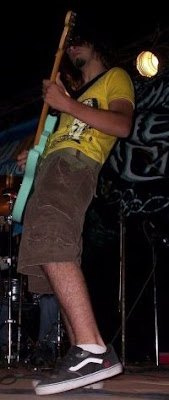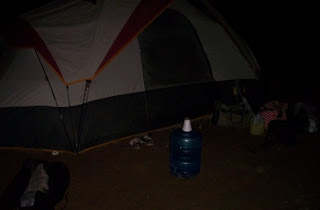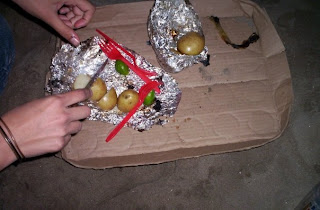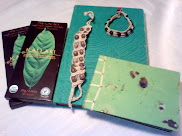The politics of tree planting are a lot more attractive at the planting stage than at the management stage, and people are noticing. The Mexican chapter of Greenpeace recently "instructed" president Calderon about his tree planting program in this video:
--
One of Us, One of Them, Part 2
After a short interlude with a boy who was looking to buy some worms for his school's compost*, Eulalio sent Millie and I over to the vivero (nursery) across the street.
We had only a difficult to pronounce name, Merari, to guide us, and it showed. We talked to the guard, who had no idea what we were talking about, until some lady overheard us and pointed us toward the correct office.
We found Merari and talked to her about CONAFOR, the Mexican government forestry department whose local office we were in. She told us there were three divisions that could do reforestation projects: Environmental Compensation, which deals with payment for environmental services (we need one of demz in the US!), Reforestation proper, and Special Projects. Obviously, most of the projects are done by the reforestation division, byt Environmental Compensation might pay for a reforestation to prevent erosion, restore an aquifer, etc, and there might be a Special Project that happens to be a reforestation.
Locally, the three main benefactors of reforestation have been Bimbo (a mexican bread giant), Cemex (a cement company), and Coca-Cola. Conafor provided the trees and expertise, while the corporate partners provided some funding and the land to be reforested. It seems that the problem in Sonora is not so much finding the trees to plant or even the land to plant them on... the main problem is follow up.
Last year, Mexico set records for the most trees planted in one day, but as I was asking Merari and her colleague where one of those plantings was, the latter perked up and said "I wonder how its doing?" Which is what happens when your tree planting budget is a lot bigger than your monitoring budget.
We walked around the nursery a bit, but Merari explained it was rather empty because CONAFOR is trying to get out of the nursery buisiness and is begginging to outsource most of its tree seedling production. This is actually cheaper for CONAFOR since it doesn't have to maintain all of that pesky nursery infrastructure, and it helps keep the commercial nurseries in buisiness. In fact, Merari says that now there are nurseries that specialize in providing tree plugs for reforestation.
What plants there were in the nursery were from what Merari called "Productive Projects," another division of CONAFOR, and they were mostly agave plugs for tequila and pine seedlings for wood production. "They really shouldn't be here," she said, "they were supposed to get picked up a while back."**
We thanked Merari and headed back. As we were walking, we started talking about how lost I would have been without Millie. All day long she had been filling in words while I got stick, taking the right buses to get where we were going, etc. I think this is a good model, bringing someone along who is from the area.
"It'll be just like Heroes," I joked, "One of us, One of them!"
--
*Boy: "Where can I get some worms?"
Eulalio: "Find a place thats always wet."
->Boy looks confused at Eulalio's misinterpretation of his question<- ->Andon hides a chuckle<-
** Unfortunately, the pictures and video from this trip were lost in a terrible act of stupidity by yours truly.
We had only a difficult to pronounce name, Merari, to guide us, and it showed. We talked to the guard, who had no idea what we were talking about, until some lady overheard us and pointed us toward the correct office.
We found Merari and talked to her about CONAFOR, the Mexican government forestry department whose local office we were in. She told us there were three divisions that could do reforestation projects: Environmental Compensation, which deals with payment for environmental services (we need one of demz in the US!), Reforestation proper, and Special Projects. Obviously, most of the projects are done by the reforestation division, byt Environmental Compensation might pay for a reforestation to prevent erosion, restore an aquifer, etc, and there might be a Special Project that happens to be a reforestation.
Locally, the three main benefactors of reforestation have been Bimbo (a mexican bread giant), Cemex (a cement company), and Coca-Cola. Conafor provided the trees and expertise, while the corporate partners provided some funding and the land to be reforested. It seems that the problem in Sonora is not so much finding the trees to plant or even the land to plant them on... the main problem is follow up.
Last year, Mexico set records for the most trees planted in one day, but as I was asking Merari and her colleague where one of those plantings was, the latter perked up and said "I wonder how its doing?" Which is what happens when your tree planting budget is a lot bigger than your monitoring budget.
We walked around the nursery a bit, but Merari explained it was rather empty because CONAFOR is trying to get out of the nursery buisiness and is begginging to outsource most of its tree seedling production. This is actually cheaper for CONAFOR since it doesn't have to maintain all of that pesky nursery infrastructure, and it helps keep the commercial nurseries in buisiness. In fact, Merari says that now there are nurseries that specialize in providing tree plugs for reforestation.
What plants there were in the nursery were from what Merari called "Productive Projects," another division of CONAFOR, and they were mostly agave plugs for tequila and pine seedlings for wood production. "They really shouldn't be here," she said, "they were supposed to get picked up a while back."**
We thanked Merari and headed back. As we were walking, we started talking about how lost I would have been without Millie. All day long she had been filling in words while I got stick, taking the right buses to get where we were going, etc. I think this is a good model, bringing someone along who is from the area.
"It'll be just like Heroes," I joked, "One of us, One of them!"
--
*Boy: "Where can I get some worms?"
Eulalio: "Find a place thats always wet."
->Boy looks confused at Eulalio's misinterpretation of his question<- ->Andon hides a chuckle<-
** Unfortunately, the pictures and video from this trip were lost in a terrible act of stupidity by yours truly.
One of Us, One of Them, Part 1
 Millie and I set off again today to visit a couple of tree nurseries. Both of these nurseries provide tree seedlings for "Reforestations" which in Mexico seems to mean any type of tree planting, including city parks!
Millie and I set off again today to visit a couple of tree nurseries. Both of these nurseries provide tree seedlings for "Reforestations" which in Mexico seems to mean any type of tree planting, including city parks!The first nursery we visited was run by the Ecological and Sustainable Development Commission of the State of Sonora, and was designed to provide native plants like mesquite, palo fierro, and bugambilia (which apparently isnt native, but isn't invasive either since its sterile) to "urban reforestations" like parks, schools, even backyards. We spoke to "Ingeniero" Eulalio* as he showed us around and told us about all the advantages of native plants: less maintenence, less water use, more pride of place, more wildlife habitat. These were not news to me, but hearing them from a man that reminded me of my Abuelito (Grandfather**) was a new experience. Eulalio has the manner of a mexican farmer and the knowledge of an field ecologist. He's shy, calm, and casual, yet it seemed that he was almost holding back a huge resevouir of practical wisdom in his head.
As we sere talking, a man approached us to ask if he could take a palo fierro tree home. "Its not in season yet, sorry," replied Eulalio "come back in a couple of months." The man didn't like this, but Eulalio told him that if he were to plant the tree today, it would surely die because it was too small. Eventually Eulalio forwarded him to a commercial nursery, but what struck me was the lack of a profit motive in his manner.
"Oh, we can't sell trees," he explained, "no man, if we could sell trees, we'd be all over the place, selling trees to anyone without care about whether or not they make it. Thats whats been happening with some of these 'reforestations,' the government gives people money to plant trees, but they just stick them in the ground without watering them. Sometimes they don't even do that! They found a pile of tree seedlings one time that was supposed to be a reforestation."
"What do you think the mortality is on a project like that without watering?" I asked with Millie's help.
"A hundred and ten percent," we laughed while my heart sank, "I don't think any of those trees are going to make it."
--
*Note: in Spanish speaking countries, the idea of calling someone doctor as a title had been expanded to include everthing one can study. Eulalio is an environmental Ingeniero, or engineer.
** Another note: this blog is going to become increasingly bilingual. I'm fighting hard against the urge to switch to spanish completely, so if you don't want to learn the language of most of your hamisphere thats your problem.
Biodiversidad y Desarollo Armonico
I'm in Hermosillo, getting ready to switch from "visiting family" mode to "reforestation" mode and head south. I made my first visit today to the offices of a group that works on biodiversity issues, including restoration, throughout Sonora. Their name translates to "Harmony between Biodiversity and Development."
Hermosillo is the capital and the largest city in Sonora, so lots of state wide groups have offices here even though their projects are hours away. I've seen this pattern before, and I guess its something I'm going to have to get used to.
My cousin Millie came alolng to guide me through the bus system, and because she's a bit bored. Her university administration is on strike, which apparently is nothing new, since they do it every year.
We found the place and knocked on the unmarked door, to be greeted by the realization that I had forgotten everyone's name! I introduced us and awkardly asked for Eduardo (the director) by saying "E...e...e..." until the man at the front door finished the name for me. Fortunately, they were totally understanding and approachable, "totally normal" people as Millie commented later. Eduardo asked me to explain what I was doing (we had talked on the phone a couple of weeks prior). I told him I was traveling Mexico visiting restoration projects and the people involved in them.
We talked for about an hour, and he told me about their main restoration project in the border region of Sonora, which of course I cant see cuz its 8 hours away. Towards the end of the conversation, well after I had asked them if they could connect me to any other projects, Eduardo casually mentioned that his wife was director of the Alamos Reserve. My jaw dropped. What a connection! I'm planning on visiting that reserve, located arond a beutiful old Spanish mission town, and having someone's wife as a toplevel connection should be really helpful.
As we were heading out, the man who had greeted us dropped another one. He'd been sitting there quietly the whole time, and just now let us know that he was the director of restoration!
Millie and I left talking about how open and friendly they were, and it exciting that Millie seemed genuinely interested and engaged both during and after the meeting. Sometimes I forget how smart she is...
I love you Millie!
--
Hermosillo is the capital and the largest city in Sonora, so lots of state wide groups have offices here even though their projects are hours away. I've seen this pattern before, and I guess its something I'm going to have to get used to.
My cousin Millie came alolng to guide me through the bus system, and because she's a bit bored. Her university administration is on strike, which apparently is nothing new, since they do it every year.
We found the place and knocked on the unmarked door, to be greeted by the realization that I had forgotten everyone's name! I introduced us and awkardly asked for Eduardo (the director) by saying "E...e...e..." until the man at the front door finished the name for me. Fortunately, they were totally understanding and approachable, "totally normal" people as Millie commented later. Eduardo asked me to explain what I was doing (we had talked on the phone a couple of weeks prior). I told him I was traveling Mexico visiting restoration projects and the people involved in them.
We talked for about an hour, and he told me about their main restoration project in the border region of Sonora, which of course I cant see cuz its 8 hours away. Towards the end of the conversation, well after I had asked them if they could connect me to any other projects, Eduardo casually mentioned that his wife was director of the Alamos Reserve. My jaw dropped. What a connection! I'm planning on visiting that reserve, located arond a beutiful old Spanish mission town, and having someone's wife as a toplevel connection should be really helpful.
As we were heading out, the man who had greeted us dropped another one. He'd been sitting there quietly the whole time, and just now let us know that he was the director of restoration!
Millie and I left talking about how open and friendly they were, and it exciting that Millie seemed genuinely interested and engaged both during and after the meeting. Sometimes I forget how smart she is...
I love you Millie!
--
Ghosts in the Machine
Still in Obregon, doing a bit of online research before heading to Hermosillo, and I've discovered a few tools that may be useful if you're ever in the third world trying to see environmental projects. Twice this week I've come across very clear links to websites that no longer exist. This often happens when an organization either stops paying for their web domain or switches to a new one. But all hope is not lost! The cool thing about living in the future is that once something is online, it is almost impossible to delete it completely.
Two ways to recover a dead page are to use the Google cache and the Internet Archive. The Google cache is a lot easier to explain and to use, but may only work if the site has died recently. Google scans the web in order to search it, and it makes little copies of everything it finds (I think it exludes pictures and video to save space). That little copy is the cache, and it gets continually updated as Google makes new scans of the web. To use the Cache, just search for the site you want, make sure the link is still broken, then go back and click the "cached" link under the google result.
The Internet Archive is another beast altogether. Its a project meant to preserve the fleeting, ever changing information on the Internet by taking regular "snapshots." As such, it can not only show you what a site looked like before it went down, it can show you what that site looked like four years ago, or 6, or even ten! It does require a little more web saavy to use, but its totally worth it.
Go to the Internet Archive in one window (or tab, tabs are infinetly better) and your dead link in another. Copy the address from the dead link and paste it into the "Wayback Machine" box in the archive. Once you click, you should see a list of links that look like dates. Click around through these until you find one that works and PRESTO! You've got yourself a zombie website!
--
Two ways to recover a dead page are to use the Google cache and the Internet Archive. The Google cache is a lot easier to explain and to use, but may only work if the site has died recently. Google scans the web in order to search it, and it makes little copies of everything it finds (I think it exludes pictures and video to save space). That little copy is the cache, and it gets continually updated as Google makes new scans of the web. To use the Cache, just search for the site you want, make sure the link is still broken, then go back and click the "cached" link under the google result.
The Internet Archive is another beast altogether. Its a project meant to preserve the fleeting, ever changing information on the Internet by taking regular "snapshots." As such, it can not only show you what a site looked like before it went down, it can show you what that site looked like four years ago, or 6, or even ten! It does require a little more web saavy to use, but its totally worth it.
Go to the Internet Archive in one window (or tab, tabs are infinetly better) and your dead link in another. Copy the address from the dead link and paste it into the "Wayback Machine" box in the archive. Once you click, you should see a list of links that look like dates. Click around through these until you find one that works and PRESTO! You've got yourself a zombie website!
--
Reforestation in Sign Language
We've left the beach and I've headed to Obregon to spend a few days with my cousins Julia, Mayito, and Rocio. Julia is studying special education and focusing on the deaf, so she's been teaching me a little bit of sign language. Check out the video below to learn how to say "New Forest" (which is kind of like reforestation) in Mexican Sign Language!
--
--
Conversations with the Can Fairy
I woke up this morning before everyone else and quietly snuck out of the tent to go lay on the sand. As I lay there watching wind erosion in miniature, a woman came by with her two kids to collect our cans from the night before. I thanked her for picking up after us, which I guess threw her off since most people think of these can collectors as some sort of street scum.
She sent her kids off to look at another campsite, and I asked her how many cans were in a kilo. "Well, it depends," she said, "If there's a lot of the big tall cans or just little ones." She paused. "But I guess its about 60 to 70 cans in a kilo"
"And where do you sell them?"
"Oh, any scrap metal place will buy them... But it used to be a lot better you know. They used to pay 17, 18 pesos for a kilo, but now its just 9."
She left me wondering what her life must be like, and feeling angry that what she was doing was percieved by the public as a poor persons scavenging rather than a grassroots recycling program.
--
She sent her kids off to look at another campsite, and I asked her how many cans were in a kilo. "Well, it depends," she said, "If there's a lot of the big tall cans or just little ones." She paused. "But I guess its about 60 to 70 cans in a kilo"
"And where do you sell them?"
"Oh, any scrap metal place will buy them... But it used to be a lot better you know. They used to pay 17, 18 pesos for a kilo, but now its just 9."
She left me wondering what her life must be like, and feeling angry that what she was doing was percieved by the public as a poor persons scavenging rather than a grassroots recycling program.
--
Mexican Metal
Later that night at the rock show, I found myself caught between excitement at seeing metal bands in Mexico and dread at the cultural imperialism that entailed. The first few bands played mostly covers of Gringo songs, so it wasn't until later that I began to hear more creative, more original, more Mexican compositions.
One band in particular, Mexico Cabron, made me realize that people weren't just copying US metal, they were transforming and owning the music. In fact, Mexico Cabron played a screaming, deep voiced metal cover of the Mexican National Anthem, which it has to be said was made to be a metal song. For cryin out loud, the first line of the anthem translates to "Mexicans at the cry of war!" It doesn't get much more metal than that.
METAL ANTHEM! Note: This type of music sounds terrrrrible on computer speakers, so dont judge me.

My experience with a lot of my cousins and friends since I left Sonora has been one of flashes, a few days of their lives every few years. In Mayito's case, the my memories of him as a shy, funny little kid would have never led me to believe that I would show up one day and suddenly see him transformed into a local rock star.
One band in particular, Mexico Cabron, made me realize that people weren't just copying US metal, they were transforming and owning the music. In fact, Mexico Cabron played a screaming, deep voiced metal cover of the Mexican National Anthem, which it has to be said was made to be a metal song. For cryin out loud, the first line of the anthem translates to "Mexicans at the cry of war!" It doesn't get much more metal than that.
Normal Anthem.
METAL ANTHEM! Note: This type of music sounds terrrrrible on computer speakers, so dont judge me.
The mosh pits got going, and apparently I was knocking down people left and right, though I didn't notice because I was just moshing like I normally do. The difference is that in Mexico I'm a lot bigger than I am in the US, compared to the general populace.
My cousin Mayito's band Blasperma played last, and almost didn't get to play because the band before them went on for too long, but they put themselves on stage and rocked out for 4 songs. In fact, they rocked so hard they started a  fight (a good sign in this genre). Blasperma was the youngest band on stage, and though most of their songs were (creative) covers, they still had a distinctly original feel to them. At the end of one song, the long haired lead singer let out a huge "AiAiAiAi AAY!"
fight (a good sign in this genre). Blasperma was the youngest band on stage, and though most of their songs were (creative) covers, they still had a distinctly original feel to them. At the end of one song, the long haired lead singer let out a huge "AiAiAiAi AAY!"
 fight (a good sign in this genre). Blasperma was the youngest band on stage, and though most of their songs were (creative) covers, they still had a distinctly original feel to them. At the end of one song, the long haired lead singer let out a huge "AiAiAiAi AAY!"
fight (a good sign in this genre). Blasperma was the youngest band on stage, and though most of their songs were (creative) covers, they still had a distinctly original feel to them. At the end of one song, the long haired lead singer let out a huge "AiAiAiAi AAY!" 
My experience with a lot of my cousins and friends since I left Sonora has been one of flashes, a few days of their lives every few years. In Mayito's case, the my memories of him as a shy, funny little kid would have never led me to believe that I would show up one day and suddenly see him transformed into a local rock star.
Rock on Mayito, Rock on.
Sociodegradable Metal
Today my cousin Mario (Mayito when we were kids) arrived at our beach encampment, and man is he big! I dont know why I was expecting a 10 year old skinny little kid, not a guy about my size with long hair and a goatee.
There's a rock show tonight, and his metal band, "Blasperma" (a combination of the words for blasphemy and sperm in Spanish) is playing. But right now we're just sitting on the beach, catching up and watching his band mates and a group of guys they bring along for mosh pits re-enact some Lucha Libre.
Mayito's friend chides him for leaving a beer can on the beach, and he tries to explain to her that cans are biodegradable, because as soon as you leave them on the ground they're gone. You see, recently the scap metal dealers realized they could make money by recycling aluminum. Rather than set up curbside recycling, educating people on how to separate their trash, etc, they simply started offering 10 pesos ($0.80) for a kilo of cans. Nowadays, there's people who are making a living off of collecting cans, with the effect that if you throw a can on the ground and turn around for a minute its gone.
So Mayito comes to me for backup on his biodegradable theory, and we come up with a new word to describe the phenomenon: Sociodegradable. Though it started as a joke, I think its actually a really useful term, and could be applied to any material valuable enough that it gets picked up and sold by "la sociedad" (society). I haven't seen a can on the ground since I got here, and it seems that with government support, other materials like paper or plastic could become "sociodegradable."
Its interesting to note that this whole system for recycling aluminum - far more efficient than anything I've seen in the US - arose without reference to the the environment and without government support. Its completely based on profit. So efficient, so simple as to be largely invisible, it is a good example of what can happen when a waste product suddenly becomes valuable.
And if you're wondering what any of this has to do with restoration ecology, beyond the obvious fact that it helps reduce litter, I'll tell ya. I think a similar model could be applied to invasive plant control. First, you create a product, preferrably a mass producible one, that requires the invasive as an input. After you´ve used up all of the plant around your facility, you could set a price for the raw material and just watch it come in. Every plant that comes in after that is being removed from a natural area somewhere, to the benefit of that area. The industrial age has proven that we're quite good at eliminating species, and making invasive plants sociodegradable could use our worst tendencies to the benefit of the planet.
--
There's a rock show tonight, and his metal band, "Blasperma" (a combination of the words for blasphemy and sperm in Spanish) is playing. But right now we're just sitting on the beach, catching up and watching his band mates and a group of guys they bring along for mosh pits re-enact some Lucha Libre.
Mayito's friend chides him for leaving a beer can on the beach, and he tries to explain to her that cans are biodegradable, because as soon as you leave them on the ground they're gone. You see, recently the scap metal dealers realized they could make money by recycling aluminum. Rather than set up curbside recycling, educating people on how to separate their trash, etc, they simply started offering 10 pesos ($0.80) for a kilo of cans. Nowadays, there's people who are making a living off of collecting cans, with the effect that if you throw a can on the ground and turn around for a minute its gone.
So Mayito comes to me for backup on his biodegradable theory, and we come up with a new word to describe the phenomenon: Sociodegradable. Though it started as a joke, I think its actually a really useful term, and could be applied to any material valuable enough that it gets picked up and sold by "la sociedad" (society). I haven't seen a can on the ground since I got here, and it seems that with government support, other materials like paper or plastic could become "sociodegradable."
Its interesting to note that this whole system for recycling aluminum - far more efficient than anything I've seen in the US - arose without reference to the the environment and without government support. Its completely based on profit. So efficient, so simple as to be largely invisible, it is a good example of what can happen when a waste product suddenly becomes valuable.
And if you're wondering what any of this has to do with restoration ecology, beyond the obvious fact that it helps reduce litter, I'll tell ya. I think a similar model could be applied to invasive plant control. First, you create a product, preferrably a mass producible one, that requires the invasive as an input. After you´ve used up all of the plant around your facility, you could set a price for the raw material and just watch it come in. Every plant that comes in after that is being removed from a natural area somewhere, to the benefit of that area. The industrial age has proven that we're quite good at eliminating species, and making invasive plants sociodegradable could use our worst tendencies to the benefit of the planet.
--
Semana Santa
The reason for the particular timing of my trip to Mexico was so I could arrive in time for Holy Week (the week before Easter for those of us that are going to Hell). In Sonora, Semana Santa is prty much beach week, and many of my family members and friends would be in Huatabampito, a beautiful, unknown beach right next to Huatabampo, where my mom grew up. We set up a tent in front of the house of a friend played in the sand and the warm (for me) water, and even saw some dolphins swim by.
The pictures show what words can only say:
The pictures show what words can only say:

We set up our tent in the middle of the night, but it was alright cuz Romualdo and I are pro.

Romualdo looking very pensive in the tent, with Millie and her brother Eduardo (on her butt).
 My first nephew (Alex) after I buried him and drew his body. He's 4 years old and adorable!
My first nephew (Alex) after I buried him and drew his body. He's 4 years old and adorable! Primita Julia (my little cousin Julia). Shes always like this.
Primita Julia (my little cousin Julia). Shes always like this. Julia and Milly are vegetarians, so I taught them an old trick from my hippie friends: wrap some onions and potatoes up in foil and throw them in the fire.
Julia and Milly are vegetarians, so I taught them an old trick from my hippie friends: wrap some onions and potatoes up in foil and throw them in the fire. A whole bunch of cousins and some friends. From left to right: Milly, Alex, Romualdo, Julia, Eduardo and Julia's friends Gaby and Mayra.
A whole bunch of cousins and some friends. From left to right: Milly, Alex, Romualdo, Julia, Eduardo and Julia's friends Gaby and Mayra.
Subscribe to:
Posts (Atom)



